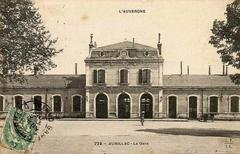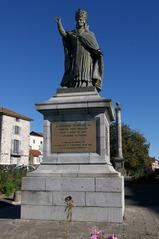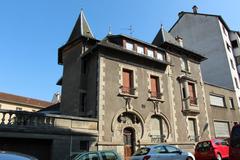Fanum d’Aron Visiting Hours, Tickets, and Historical Sites in Aurillac, France
Date: 04/07/2025
Introduction
The Fanum d’Aron, located in the heart of Aurillac, France, is a unique archaeological site that bears witness to the rich spiritual and cultural heritage of the Gallo-Roman era. This Romano-Celtic temple, dating from the 1st to the 3rd century CE, stands out for its rare polygonal architecture and the remarkable blending of Celtic and Roman traditions. Discovered during salvage excavations in the late 1970s, the Fanum d’Aron provides invaluable insights into the syncretism and community life of the ancient Arverni people. Today, it is freely accessible and complemented by museum displays in Aurillac, allowing visitors to immerse themselves in the region’s layered history.
This comprehensive guide covers the historical and archaeological significance of the Fanum d’Aron, practical visitor information regarding hours and ticketing, tips on accessibility, and suggestions for exploring Aurillac’s broader historical landscape. For further details, visitors can consult resources such as Pays d’Aurillac Tourisme, the Musée d’Art et d’Archéologie d’Aurillac, and the official Aurillac tourism website.
Historical Background and Archaeological Significance
Discovery and Excavation
The Fanum d’Aron was unearthed in 1977 during emergency archaeological excavations in Aurillac’s Lescudillier district, prompted by urban development (Wikipedia; Musees Aurillac). Catalogued as BE n°360, the site is located near Rue Jacques Prévert, within a municipal garden and adjacent to the Lescudillier industrial zone (Wikiwand). Excavations from 1977 to 1978 revealed the oldest known remains in Aurillac (Actu.fr). Recognizing its significance, the French Ministry of Culture designated the site a Monument Historique in 1980 (fr.wikipedia).
Historical and Regional Context
Dating from the early Roman Empire, the Fanum d’Aron was in use from the 1st to the 3rd century CE, during the period of Romanization of the Arverni territory (Musees Aurillac; Wikiwand). The temple’s strategic location on a plain at the confluence of the Cère and Jordanne valleys (at 640 meters altitude) and its proximity to a sacred spring reflect its importance as a spiritual and communal center (fr.wikipedia). As part of a vicus, the site illustrates the integration of Gallic communities into Roman religious and administrative frameworks (Pays Aurillac Tourisme).
Architectural Features
The Fanum d’Aron stands apart for its rare polygonal plan, a feature uncommon among Arverni temples, which were typically quadrangular (Wikiwand). Its layout includes:
- Cella: An 8-meter-diameter central sanctuary reserved for priests and the cult statue. Doors were opened during ceremonies, symbolically inviting the deity to protect the community (Pays Aurillac Tourisme).
- Ambulatory: A 16-sided polygonal corridor, alternating walls and column bases, facilitating ritual processions and demarcating sacred space. Eight of the sixteen column bases were found in situ (Musees Aurillac).
- Columns and Capitals: Fluted Corinthian columns adorned with acanthus leaves, with several capitals sculpted to represent celestial deities such as the Sun and Moon (Wikiwand).
This architectural style exemplifies the Western Gaulish fanum, with parallels at Mauriac, Saint-Gervais, and Chassenon (fr-academic.com).
Archaeological Finds
Excavations yielded:
- Lapidary Elements: Column drums, capitals, and sculpted heads in trachyte.
- Ceramics and Terracotta: Domestic and ritual pottery, architectural pieces such as antefixes.
- Metal and Glass Artifacts: Everyday items and ritual objects, including coins for dating the site.
- Sculptural Fragments: Notably, heads representing celestial deities.
Artifacts from the site are exhibited in the Musée d’Art et d’Archéologie d’Aurillac alongside a scale model of the temple.
Religious and Cultural Significance
The Fanum d’Aron embodies the syncretism of Celtic and Roman religious practices. Its architecture and rituals reflect enduring Gallic customs adapted to Roman forms, and the presence of a sacred spring suggests connections to water cults frequent in both traditions (Pays Aurillac Tourisme; fr.wikipedia). The temple remained a religious center until the 3rd or 4th century, likely replaced by Christian sites.
Comparative Sites
The Fanum d’Aron is part of a network of ancient sanctuaries in Cantal, with parallels at Landeyrat, Allanche, Celles, Charmensac, and Mauriac Vernols. The Mauriac temple, featuring a round cella and decagonal ambulatory, closely resembles the Fanum d’Aron (fr-academic.com).
Visitor Information
Visiting Hours
- Fanum d’Aron Site: Open-air, freely accessible year-round during daylight hours.
- Musée d’Art et d’Archéologie d’Aurillac: Open Tuesday to Sunday, 10:00 AM to 6:00 PM.
Tickets and Admission
- Fanum d’Aron Site: Free entry.
- Museum: €5 for adults, with discounts for students and seniors. Children under 18 enter free.
Accessibility
- The site features paved paths and is generally wheelchair accessible.
- The museum is equipped with ramps and elevators.
Guided Tours
- Guided tours are available seasonally and during events such as European Heritage Days. Refer to the Aurillac tourism website or contact the museum for bookings.
Directions and Transportation
- Location: Near Rue Jacques Prévert in Aurillac’s Lescudillier district.
- Parking: Available near the municipal garden.
- Public Transport: Local buses connect the town center to the Lescudillier area.
Enhancing Your Visit: Nearby Historical Sites & Attractions
- Aurillac Medieval Quarter: Explore the town’s historic streets and squares.
- Saint-Géraud Church: Significant medieval abbey with rich architectural details.
- Château Saint-Étienne: Offers panoramic views and insights into Aurillac’s feudal past.
- Château de Conros: A medieval castle in Arpajon-sur-Cère, a short drive from Aurillac.
Additionally, the Fanum d’Aron’s setting near the Jordanne valley makes it an excellent base for enjoying regional landscapes along the Route des Crêtes or hiking in the Gorges de la Jordanne (France-Voyage).
Visuals and Interactive Resources
- On-site signage includes detailed maps and illustrations.
- Virtual tours, images, and interactive content can be found on the official Pays d’Aurillac Tourisme website.
- Example alt text for images: “Fanum d’Aron polygonal temple ruins in Aurillac” and “Sculpted trachyte capitals from Fanum d’Aron.”
Frequently Asked Questions (FAQ)
Q: What are Fanum d’Aron visiting hours?
A: The outdoor site is open daily during daylight hours; the museum is open Tuesday to Sunday, 10:00 AM to 6:00 PM.
Q: Are there tickets to visit Fanum d’Aron?
A: Entry to the outdoor temple site is free. Museum admission is €5 for adults, free for children under 18.
Q: Is the Fanum d’Aron site wheelchair accessible?
A: Yes, the site and garden are accessible. The museum is also fully accessible.
Q: Are guided tours available?
A: Guided tours are seasonal and during special events. Check the Aurillac tourism website for details.
Q: How do I get to Fanum d’Aron?
A: Located near Rue Jacques Prévert, accessible by car or local bus from Aurillac’s town center.
Q: Are there restrooms or cafés on site?
A: No on-site amenities; facilities are available in the town center.
Q: Can I take photographs at the Fanum d’Aron?
A: Yes, photography is permitted. Check local guidelines regarding drone use.
Travel Tips for Visiting
- Wear comfortable shoes for uneven ground.
- Bring water and plan for restroom stops in town.
- Visit early or late in the day for pleasant weather and fewer crowds.
- Respect the site by not disturbing the remains or removing artifacts.
- Be prepared for changing weather—Aurillac is known for its variable climate.
Sample Itinerary for History Enthusiasts
- Start at Fanum d’Aron for an archaeological overview.
- Walk to the Église abbatiale Saint-Géraud (approx. 14 minutes).
- Visit Château Saint-Étienne for panoramic views.
- Explore Aurillac’s medieval center and, if possible, the Château de Conros.
Responsible Tourism
Please help preserve the Fanum d’Aron by staying on marked paths, not climbing on ruins, and following posted guidelines. Your respect ensures the site can be enjoyed by future generations.
Conclusion
The Fanum d’Aron stands as a testament to Aurillac’s ancient roots and the enduring legacy of Celtic and Roman syncretism in the region. Its unique architecture, historical significance, and free access make it a highlight for any visitor interested in France’s rich archaeological and cultural tapestry. By combining your visit with other nearby attractions, you’ll gain a deeper appreciation of Aurillac’s layered history and vibrant present.
Plan your trip today, and for current information, guided tours, and cultural events, consult the Aurillac Tourist Office or download the Audiala app for interactive maps and expert tips.
Sources and Further Reading
- Musees Aurillac - Fanum d’Aron
- Pays d’Aurillac Tourisme - Fanum d’Aron
- Wikipedia - Fanum d’Aron
- Wikiwand - Fanum d’Aron
- Actu.fr - Fanum d’Aron
- France-Voyage - Aurillac
- Trek Zone - Fanum d’Aron
- Over Your Place - Aurillac
- France This Way - Aurillac
- The Crazy Tourist - Aurillac
- Audiala - Aurillac



